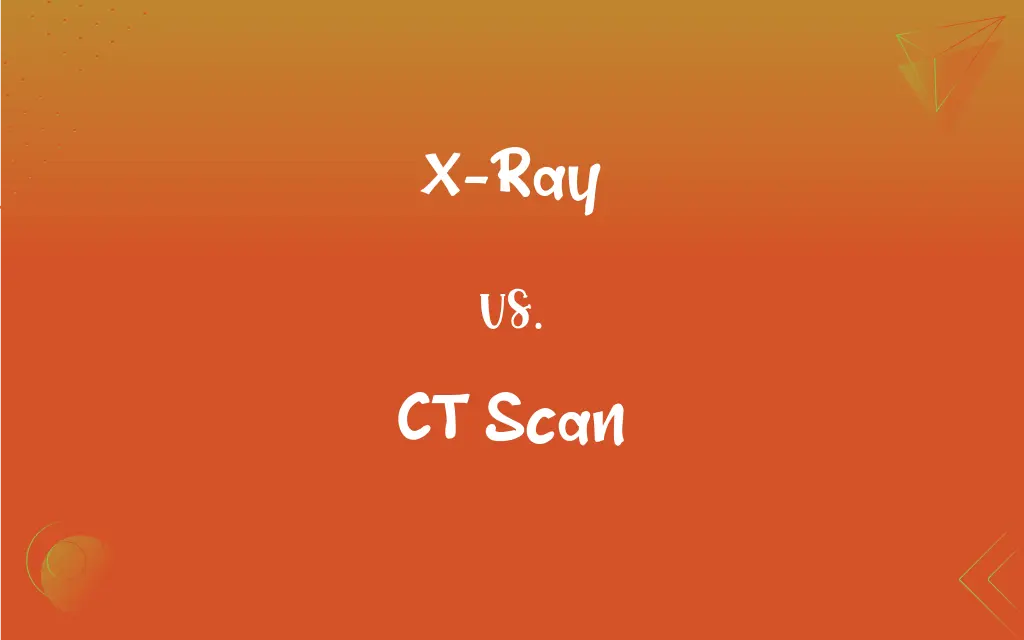X-Ray vs. CT Scan: What's the Difference?
Edited by Aimie Carlson || By Harlon Moss || Updated on October 26, 2023
An x-ray is a single image capturing the internal structure using radiation, while a ct scan produces detailed, cross-sectional images from multiple x-ray angles.

Key Differences
An x-ray is a diagnostic tool that utilizes a controlled amount of radiation to visualize the internal structures of the body, including bones, some organs, and tissues. It generates a two-dimensional image. On the contrary, a ct scan, short for computed tomography scan, uses x-ray equipment to obtain images from different angles, processing them with computer technology to produce cross-sectional slices of the body.
X-rays are typically used for examining the skeletal system, detecting fractures, infections, and tumors. They are quicker and generally more accessible. In contrast, ct scans are often used to examine complex parts of the body, like the brain, lungs, and abdominal organs, offering more detailed information.
With x-rays, the patient is exposed to a minimal amount of radiation. The process is simple and fast. In a ct scan, however, the patient is exposed to a higher radiation dose, as multiple images are captured from various angles to create detailed slices of the area of interest.
While x-rays provide a broad overview of an area, they might not capture the nuances of soft tissues or the depth of structures. Ct scans, being more detailed, can offer three-dimensional reconstructions, proving invaluable in diagnosing internal injuries, tumors, and blood clots.
In essence, while both x-rays and ct scans use radiation to capture internal images, their purposes, processes, and details differ significantly, with ct scans offering more comprehensive insights into the body's interior.
ADVERTISEMENT
Comparison Chart
Technology
Uses radiation to capture a 2D image.
Uses x-rays from multiple angles and computer processing to produce cross-sectional images.
Common Uses
Detecting fractures, infections, and certain tumors.
Examining brain, lungs, abdominal organs, and creating 3D reconstructions.
Radiation Exposure
Relatively low.
Higher due to multiple images taken from various angles.
Detail of Imaging
Provides a broad overview, less detailed for soft tissues.
Provides detailed images of soft tissues, bones, and blood vessels.
Duration
Quick and straightforward.
Takes longer as it captures multiple images for detailed analysis.
ADVERTISEMENT
X-Ray and CT Scan Definitions
X-Ray
They capture two-dimensional images of the internal body.
The x-ray showed a clear image of the patient's lungs.
CT Scan
A CT scan is a diagnostic imaging procedure using x-ray equipment.
The doctor recommended a ct scan to examine her brain.
X-Ray
X-rays are primarily used for visualizing bones and joints.
After the accident, they took an x-ray of his spine.
CT Scan
It creates detailed cross-sectional pictures of the body's interior.
The ct scan provided a layered view of the abdominal organs.
X-Ray
The technique uses a small dose of ionizing radiation.
Pregnant women are usually advised to avoid unnecessary x-rays.
CT Scan
The procedure can reconstruct three-dimensional images.
The ct scan allowed the surgeon to visualize the tumor's exact location.
X-Ray
X-rays can detect abnormalities like fractures or infections.
The x-ray revealed a hairline fracture in the tibia.
CT Scan
CT scans are instrumental in diagnosing internal injuries or blood clots.
After the car accident, he underwent a ct scan to rule out internal bleeding.
X-Ray
X-rays are electromagnetic waves used for medical imaging.
She broke her arm, so the doctor ordered an x-ray.
CT Scan
CT scans provide more detailed information than standard x-rays.
For complex tumors, a ct scan offers better imaging clarity.
X-Ray
A photon of electromagnetic radiation of very short wavelength, ranging from about 10 down to 0.01 nanometers, and very high energy, ranging from about 100 up to 100,000 electron volts.
FAQs
How is a ct scan different from an x-ray?
A ct scan uses x-rays from multiple angles and computer processing to produce detailed cross-sectional images, while an x-ray captures a 2D image.
How long does an x-ray procedure usually take?
An x-ray is quick, often taking only a few minutes.
Can children get ct scans?
Yes, but the decision is based on the clinical need and potential risks, considering the higher sensitivity of children to radiation.
What is the primary purpose of an x-ray?
An x-ray is used to visualize the internal structures, especially bones, to detect fractures, infections, or tumors.
Can x-rays detect infections?
Yes, x-rays can sometimes detect infections, especially in the lungs or bones.
Is a ct scan better than an x-ray for brain injuries?
Yes, ct scans provide more detailed images, making them better for diagnosing brain injuries.
Which has a higher radiation exposure: x-ray or ct scan?
CT scans typically expose the patient to higher radiation levels than x-rays.
Is an x-ray harmful?
While x-rays involve radiation, the dose is usually minimal and considered safe for most patients.
Why are ct scans commonly used in trauma cases?
CT scans offer detailed and quick imaging, making them valuable in trauma cases to diagnose internal injuries.
Can you get a ct scan during pregnancy?
CT scans during pregnancy are generally avoided unless absolutely necessary due to radiation exposure.
Why might a patient be given a contrast agent during a ct scan?
A contrast agent enhances the clarity of certain areas, making it easier to detect abnormalities.
Is there any preparation needed for an x-ray?
Usually, no special preparation is needed for an x-ray.
How long does a ct scan procedure usually take?
A ct scan can take anywhere from a few minutes to half an hour, depending on the area being examined.
Are there alternatives to x-rays and ct scans?
Yes, alternatives include MRI, ultrasound, and PET scans, each with its specific applications.
Which is better for viewing soft tissues: x-ray or ct scan?
CT scans are superior for viewing soft tissues due to their detailed cross-sectional imaging capability.
Can you see blood vessels with an x-ray?
X-rays primarily visualize bones and certain tissues, while ct scans can provide more detailed images of blood vessels.
Are there any risks associated with getting a ct scan?
Yes, there's a higher radiation exposure, and there's a small risk of allergic reaction if contrast materials are used.
Which imaging technique is more expensive?
Typically, ct scans are more expensive than x-rays.
Why would a doctor recommend a ct scan over an x-ray?
A doctor might recommend a ct scan for a more detailed view, especially for soft tissues or complex body parts like the brain or lungs.
Can x-rays detect tumors?
Yes, x-rays can detect certain tumors, but ct scans often provide clearer images of tumors.
About Author
Written by
Harlon MossHarlon is a seasoned quality moderator and accomplished content writer for Difference Wiki. An alumnus of the prestigious University of California, he earned his degree in Computer Science. Leveraging his academic background, Harlon brings a meticulous and informed perspective to his work, ensuring content accuracy and excellence.
Edited by
Aimie CarlsonAimie Carlson, holding a master's degree in English literature, is a fervent English language enthusiast. She lends her writing talents to Difference Wiki, a prominent website that specializes in comparisons, offering readers insightful analyses that both captivate and inform.































































